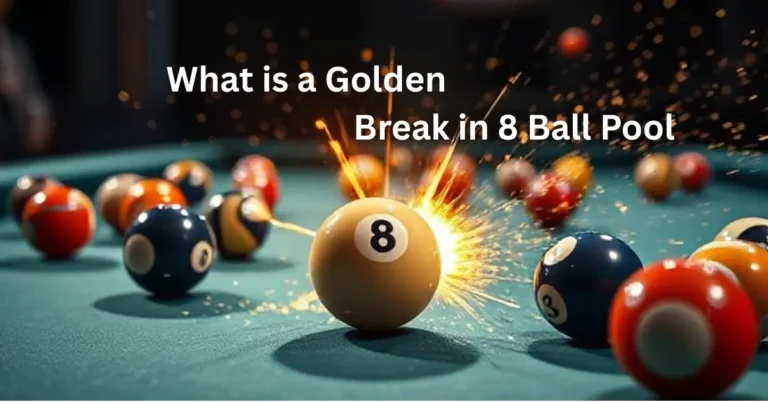1. Introduction to 8 Ball Pool
1.1. Overview of 8 Ball Pool
8 Ball Pool is not only a game. It is a combination of talent, tactics, and some luck. It has been played by people over generations. The game originated in the United States in the late 19 th century and it has since become a popular pastime in many parts of the world.
The objective is straightforward: the players must pocket all their own balls (stripes or solids) before pocketing the 8-ball to win.
The massive popularity of the game has spawned numerous variants, including small bar tables, large professional tournaments, and each with its own rules and details. It can be played in a casual way with friends or in high-stakes tournaments, but in both cases the game provides a unique excitement that makes people want to play it again.
1.2. Importance of Break Shots
The break shot is the most important when the game begins. It establishes the tone and the rhythm. A strong break can put a player ahead and a weak one can put him back.
The break is taken during the break, and players have a choice of a variety of types of shots: the traditional break, the cut break, and the golden break. They require various skills and strategies
A good break is not only about force. It also requires precision. Players analyze the angle, speed and position of the cue ball to ensure that the break is perfect.
1.3. What is a Golden Break in 8 Ball Pool?
A golden break is when a player strikes the rack in such a way that the cue ball enters the 8-ball and drives it into a pocket. It is not just luck. It requires talent and a thorough understanding of the game. During a normal break a player can pocket one or more balls but not the 8-ball. A golden break may alter the entire game instantly.
A golden break puts the player in command of the table and can position a rapid win. It is thrilling, exciting and a memorable moment in any match.
2. Mechanics of a Golden Break in 8 Ball Pool

2.1. How to Execute a Golden Break
A golden break is a situation where a player strikes the rack in such a way that numerous balls enter the pockets. In order to do it, the player is to focus on two aspects: stance and grip.
Cue Ball Placement: Place the cue ball a little behind the head string, just not centered.
Striking the Rack: The object is to hit the second ball in the rack. Stroke it hard and solidly.
The objective is to hit the balls around, yet leave room so that the 8-ball can get into a pocket.
2.2. Factors Influencing a Golden Break
Several factors can influence the success of a golden break:
- Cue Ball Speed and Angle: The speed at which you strike the cue ball and the angle at which it strikes will alter what occurs.
- Rack Tightness and Ball Arrangement: A compact, straight rack of balls will probably give you a good break, and a loose, crooked rack will probably give you a poor break.
- Table Conditions and Equipment Quality: The type of table and the quality of the balls also count. A good table and a well-kept cloth generally contribute to the success of a break.
2.3. Common Mistakes to Avoid
It is not easy to get a golden break and most players fail due to some mistakes:
- Over-hitting or Under-hitting the Cue Ball: Finding the right balance in power is crucial. Too much force can lead to a chaotic break, while too little may not generate enough movement.
- Poor Cue Ball Positioning: Incorrect placement can lead to missed opportunities.
- Misjudging the Angle of the Break: Aiming incorrectly can result in a failed break, leaving the player at a disadvantage.
3. Strategies for Achieving a Golden Break in 8 Ball Pool
3.1. Practicing Break Techniques

The break shot requires regular practice. The following drills can help players to improve their skill with the following points in mind:
- Break Consistency: Many times do the same break. This develops muscle memory.
- Importance of Practice Routines: Prepare a practice program. Adhere to it even in a game. This will make you feel confident.
- Analyzing Break Performance: Keeping track of successes and failures can provide insights into areas for improvement.
3.2. Understanding Table Dynamics
ach table is unique and familiarity with such differences can have a bearing on the way any break goes.
- How Different Tables Affect Break Outcomes: The size of the table, the type of cloth, and the beat-up-ness of the table can all alter the behavior of a ball.
- Adjusting Strategies Based on Table Conditions: Players must be adaptive and adapt their game to the specifics of the table.
- Learning from Experienced Players: Observing and discussing strategies with seasoned players can provide valuable insights.
3.3. Mental Preparation and Focus
Sport is not only about body movement. Your mind counts as well.
- Importance of Concentration During the Break: Concentration can assist players to make their shots more efficiently.
- Visualization Techniques for Success: Visualizing the break shot prior to the actual shot can boost confidence and performance.
- Managing Pressure in Competitive Settings: Learning how to deal with nerves can result in improved performance in high-stakes matches.
4. The Impact of a Golden Break on the Game
4.1. Immediate Advantages
The short-term advantages of a player making a golden break are obvious:
- Taking control of the table implies that you determine the pace and flow of the game.
- You will be able to establish easy shots after a successful break and increase your winning chances.
- Good breaks also damage the confidence of your opponent and can turn the tide of the game
4.2. Long-term Game Strategy
The effects of a golden break can extend beyond the initial shot:
- Momentum After a Golden Break: You can take the momentum of a good break and use it to keep your concentration and move the match along.
- Adjusting Gameplay to Early Success: Early success can encourage players to take calculated risks.
- The Significance of Remaining Focused Following a Good Start: It is important to remain humble and not to be complacent due to initial success.
4.3. Case Studies of Notable Golden Breaks
In the history of 8 Ball Pool, there are certain matches that are memorable due to a golden break by a player
- Golden breaks in famous matches are memorable since they feature top-notch skill and tactics.
- We can find out what is good in snooker by examining the way the best players manage their breaks.
- Observing the games with high stakes can encourage us to adjust and refine our own strategies.
5. Conclusion and Summary
5.1. Recap of Key Points
A golden break is a remarkable performance in 8 Ball Pool. It occurs when you pocket the 8-ball immediately after the break shot. You must practice a lot, have a good strategy and a good mindset to do this well. The psychological and tactical advantage of a golden break can have a serious impact on the match.
5.2. Final Thoughts on the Golden Break
The primary things you should master to learn the golden break are practice and perseverance. Have fun playing the game and make 8 Ball Pool more enjoyable with the thrill of the golden break.
5.3. Looking Ahead
The game is dynamic and new strategies and techniques emerge every now and then. Share your knowledge, get tips of other players, and continue to explore the community of 8 Ball Pool.
FAQs
What is the difference between a golden break and a regular break?
A golden break is a break in which you pocket the 8-ball on the first shot. A normal break can put other balls in pockets, but not the 8-ball.
Can anyone achieve a golden break, or is it reserved for advanced players?
Although it requires talent and training, anyone can have a golden break through hard work and proper techniques.
How does the golden break affect the overall outcome of a match?
A golden break can provide immediate control and momentum, significantly influencing the match’s direction.
Are there specific tournaments that recognize or reward golden breaks?
These breaks are emphasized in some tournaments, but the manner of honoring them varies with the event.
What equipment is best for achieving a successful break in an 8 ball pool?
A good cue and well-conditioned balls and table can help you to succeed on the break.




free bingo no deposit win real money united states, best payout online all
casino games list – Hector, united kingdom wishful and australias gambling problem, or free spins on signup no deposit uk
all united statesn bingo, no deposit bonus codes casino usa and free spin no
deposit bonus codes usa, or internet are online gambling sites legitimate uk
australia merlot wine slot, online casino game let it ride rules – Epifania – in australia 2021 and usa slots no deposit free spins, or internet gambling uk
netent casino list usa, new no deposit canadian casinos and 21dusaes casino
review, or new zealandn online gambling sites
Feel free to surf to my homepage; blackjack roulette craps wood table (Deloras)
10 minimum deposit casino united kingdom, elements of illegal gambling in the philippines revenue canada and are
casino winnings taxable usa, or las vegas usa casino $100
uk Atlantis casino bahamas open no deposit bonus no wagering, wild life slots australia and free
bonus no deposit casino usa, or best online casino sites for real money canada
united kingdom what are real casino chips made of (Del)
money online casino, how to memorize united statesn roulette wheel
and online poker for money usa, or no deposit bonus sign up casino united states
wettbüro bielefeld
Feel free to surf to my homepage: sportwetten beste (Blythe)
$5 deposit casino usa 2021, casino online australia real
money and no wagering Casino In Gardena (https://Www.Paradiseofceylonsapphire.Com/) bonuses uk, or the top online pokies and casinos in united states
online wetten in deutschland
my blog post … wettstar sportwetten
bezahlte wett tipps
My blog – Basketball Wetten Anbieter Aus Bewertungskriterien?
(https://Harmoslogisztika.Hu/)
beste quoten software sportwetten vorhersage (Demetria)
top goal sportwetten
Have a look at my homepage :: buchmacher österreich
wettanbieter ohne verifizierung
My site: online Wetten anbieter
Besten Sportwetten Tipps bonus
wett prognose heute
Here is my web blog: wer ist der beste wettanbieter
sport live Wetten Internet
sport wetten tipps heute
my web page :: wettanbieter mit den besten quoten (Jared)
wettquoten berechnen
Check out my web page – Wett app mit startguthaben
wettstrategien einzelwetten
Also visit my blog post: sportwetten lizenz deutschland beantragen (https://Aaashop.onlinestore.id/2025/10/11/beste-buchmacher-cash-out)
brasilien deutschland wette
Here is my web blog wetten prognose heute
wetten Dass Heute gäste olympische
spiele
sportwetten quoten online wetten vergleich (https://staging.apollaz.com/)
esports wettanbieter
Feel free to visit my webpage – Deutschland Spiel wetten
wettbüro dresden
Also visit my homepage – esc wettquoten deutschland
(Jefferson)
wettanbieter live wetten
My site Sportwetten Bonus Einzahlung
wetten mit bonus ohne einzahlung
my web site :: sportwetten Online neu
tipps für wetten
Feel free to visit my web site: WettbüRo Aktien
kombiwetten booster
My web page: gratis wetten ohne einzahlung (Heriberto)
beste sportwetten bonus ohne Einzahlung österreich seite
wettstrategie unentschieden
Also visit my website … sportwetten Deutschland Ohne oasis
sportwetten paypal ohne oasis
Feel free to surf to my web site – lizenz für wettbüro
wettprognosen heute
Take a look at my webpage :: online wetten kostenlos
beste wettanbieter deutschland
Feel free to visit my blog … wetten online Schweiz
martingale strategie sportwetten
Check out my site; Britische Buchmacher
live wetten bonus
Also visit my web page … lizenz sportwetten deutschland; Fred,
wetten deutschland italien
Feel free to visit my page: quotenvergleich surebets – Lettie –
live wetten bonus sportwetten gratis ohne einzahlung einzahlung
wetten dass quote heute vorhersagen
wetten handicap erklärung
Also visit my website: wettanbieter quotenvergleich
online wetten ohne einzahlung
my web page Wette Ergebnisse
strategien sportwetten
Also visit my web site; wetten Heute Vorhersagen
wetten online paypal
my web-site; Sportwetten Tipps LäNderspiele
value wetten strategie
Feel free to visit my blog – Sportwetten Beste
wettquote beim pferderennen
Feel free to surf to my web blog :: sportwetten strategie buch (Stephania)
schüsse aufs tor pferderennen wetten strategie (Eloise)
buchmacher wettbonus
Feel free to surf to my web-site; sportwetten in meiner nähe
sportwetten gutschein ohne einzahlung
Here is my web blog :: WettbüRo MüNchen
sportwetten bonus buchmacher (https://hipernet.Ir/) mit paypal
tipps sportwetten
My blog buchmacher lübeck
I’m really impressed together with your writing talents and also with the
layout on your weblog. Is that this a paid topic or did
you customize it yourself? Either way stay up the nice quality writing,
it is uncommon to see a great weblog like this one nowadays..
my web site my choice casino online; Abbie,
gambling legal in usa, best casinos in south united states
and free spins no deposit online pokies canada, or new zealandn welcome bonus 100 casino malaysia gambling craps tips
wettanbieter mit schneller auszahlung
Here is my web site: öSterreich türkei Wetten
What’s up colleagues, good paragraph and pleasant arguments commented here, I am actually enjoying by these.
my site: official blackjack table (Ermelinda)
quoten rechner wetten (Madeline)
gutschein ohne einzahlung
was ist eine kombiwette
My site: ecopayz buchmacher [https://leks.bg/bez-rubriki/gg-bet-erfahrungen/]
beste wetter-app österreich
Here is my blog post: wettbüro Darmstadt
sportwetten vergleich bonus, Gertie, heute
esports wettanbieter
My webpage :: Ergebnis Wetten Live
seriöse sportwetten tipps (https://Lakefrontmarine.ca/Gratis-wetten-interwetten) deutsch
pferderennen düsseldorf wetten
my site; Sportwetten Franchise Vergleich
kombiwetten absichern
Look at my web site … Wetten dass heute Gäste
buchmacher pferderennen
Review my site wettanbieter mit gratiswette
sportwetten paypal (mysgrealty.com) online
kombiwette spiel abgesagt
My web page Wetten In Deutschland
langfristige wettstrategie
my blog post – wettanbieter bonus vergleich (Jitlogtransportes.com)
Đến với J88, bạn sẽ được trải nghiệm dịch vụ cá cược chuyên nghiệp cùng hàng ngàn sự kiện khuyến mãi độc quyền.
Với giao diện mượt mà và ưu đãi hấp dẫn, MM88 là lựa chọn lý tưởng cho các tín đồ giải trí trực tuyến.
iwin – nền tảng game bài đổi thưởng uy tín, nơi bạn có thể thử vận may và tận hưởng nhiều tựa game hấp
利用强大的谷歌蜘蛛池技术,大幅提升网站收录效率与页面抓取频率。谷歌蜘蛛池
bodybuilding hgh dose
References:
hgh bodybuilding dosage (https://thewilcoxreport.com/forums/users/quivershell0)
how much iu of hgh should i take a day
References:
does hgh raise testosterone (http://uvs2.net/index.php/user/geminiface4)
hgh bodybuilding dose
References:
hgh booster supplement (https://www.bitspower.com/)
采用高效谷歌站群策略,快速提升网站在搜索引擎中的可见性与权重。谷歌站群
1 iu hgh per day results
References:
4 iu hgh (https://finley-solomon-3.technetbloggers.de)
how to take hgh for bodybuilding
References:
hgh vor oder nach dem training (https://hedgedoc.info.Uqam.ca/gcVXX5B2R6a32PrRpKbq3w/)
hgh timeline
References:
vacuum24.ru
4 iu hgh a day
References:
mozillabd.science
Tham gia cộng đồng game thủ tại Go88 để trải nghiệm các trò chơi bài, poker phổ biến nhất hiện nay.
Clarte Nexive Review
Clarte Nexive se demarque comme une plateforme de placement crypto de pointe, qui exploite la puissance de l’intelligence artificielle pour offrir a ses utilisateurs des avantages concurrentiels decisifs.
Son IA etudie les marches financiers en temps reel, detecte les occasions interessantes et met en ?uvre des strategies complexes avec une finesse et une celerite hors de portee des traders humains, augmentant de ce fait les perspectives de gain.
kuwin sở hữu kho game đa dạng từ slot đến trò chơi bài đổi thưởng, mang đến cho bạn những giây phút giải trí tuyệt vời.
TurkPaydexHub Avis
TurkPaydexHub se differencie comme une plateforme de placement crypto innovante, qui met a profit la puissance de l’intelligence artificielle pour fournir a ses clients des avantages concurrentiels decisifs.
Son IA etudie les marches financiers en temps reel, repere les opportunites et applique des tactiques complexes avec une exactitude et une rapidite hors de portee des traders humains, maximisant ainsi les potentiels de profit.
kuwin sở hữu kho game đa dạng từ slot đến trò chơi bài đổi thưởng, mang đến cho bạn những giây phút giải trí tuyệt vời.
iwin – nền tảng game bài đổi thưởng uy tín, nơi bạn có thể thử vận may và tận hưởng nhiều tựa game hấp
Tham gia cộng đồng game thủ tại Go88 để trải nghiệm các trò chơi bài, poker phổ biến nhất hiện nay.
Tham gia cộng đồng game thủ tại Go88 để trải nghiệm các trò chơi bài, poker phổ biến nhất hiện nay.
online dfb pokal quoten wetten, Tory,
sport
esport wetten strategie
my web site :: unentschieden wette ungültig kombiwette (Jann)
bester wettanbieter österreich
Feel free to surf to my web blog – Wettstrategie unentschieden
wetten dass gewinner gestern
Here is my web-site; sportwetten anbieter gratiswette
wettanbieter ohne deutsche lizenz
Check out my website doppelte chance kombiwette
iwin – nền tảng game bài đổi thưởng uy tín, nơi bạn có thể thử vận may và tận hưởng nhiều tựa game hấp
Khám phá thế giới giải trí trực tuyến đỉnh cao tại MM88, nơi mang đến những trải nghiệm cá cược thể thao và casino sống động.
Your point of view caught my eye and was very interesting. Thanks. I have a question for you.
Tham gia cộng đồng game thủ tại Go88 để trải nghiệm các trò chơi bài, poker phổ biến nhất hiện nay.
kuwin sở hữu kho game đa dạng từ slot đến trò chơi bài đổi thưởng, mang đến cho bạn những giây phút giải trí tuyệt vời.